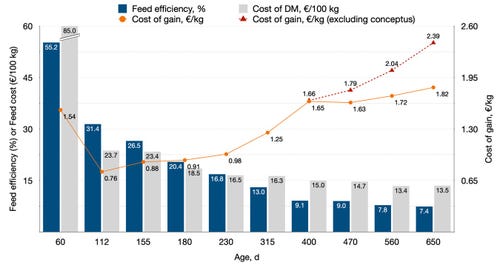Dairy calf and heifer growing efficiencies
Conversion of nutrients for dairy calves and heifers is greatest at the youngest age but then what?
April 20, 2022

By Al Kertz, PhD, DIPL ACAN
ANDHIL LLC
[email protected]
ww.andhil.com
Feed efficiency is not well understood or appreciate in dairy circles. I became much more attuned to this issue when I did some consulting work over several years around 2006 when working with Rancho Las Nieves (RLN) in north central Spain. It may be debatable whether they learned more from me or vice versa. The RLN is unique in several aspects. It raises about 6,000 calves and heifers annually, but from about 130 dairy farm clients. Thus, it has specific biosecurity protocols to gather and commingle calves from so many locations. They also make many measurements and have extensive data like no other calf/heifer operation that I am aware of. The managing partner is Jose (Pepe) Ahedo whose family is involved in some dairy farm operations themselves. The lead author on this paper (Bach et al. 2021) is Alex Bach who manages his own research group in Barcelona. I have known him for about 20 years. He is very bright and we have an engaging scientific relationship. That means we do not always agree on feeding and managing calves and heifers, but have amicable discussions when we disagree. And that is the way science should be.
The prelude above is the basis for why I recommended that when an ARPAS (American Registry of Professional Animal Scientists www.arpas.org) symposium was being organized two years ago on dairy efficiency, that Bach should be the lead author and presenter (I should also acknowledge that I am a past-president and now executive vice president of ARPAS).
There are little published data on dairy calf and heifer growing efficiencies. But I knew Bach had access to the extensive RLN database and had the capability to extract and evaluate from those data. For about 10 years, I have used in various writings and presentations data Bach provided me from RLN (Figure 1). 
Note the best feed efficiencies (FE) by far are during the first 2 months of age. These FE are not far off from growing pigs and chickens. Yet, the cost per lb of milk replacer and starter fed during that period are the greatest during then entire heifer growing period. Unfortunately, that is why too much attention is paid to the greatest costs per lb during the period when the best FE is realized. Why scrimp on feed costs when the greatest FE are present? Instead, we should be trying to realize the greatest conversion of nutrients to growth during this first 60 days. Note that as heifers got older and ate more, daily gains averaged about 2 lb daily, That means that FE became progressively poorer and poorer from less that 2 to over 12 for the largest heifers.
As heifers grow and their body weight increases, more of their nutrient intake must go towards maintaining their increasing body weight before nutrients can be available for additional growth. This is depicted in Figure 2 (NRC 2001) which shows how much more of energy intake is available for growth as energy intake increases. Of course, this assumes all other nutrient are balanced along with the energy intake. Because of this increased FE at a young age, cost per lb of gain can also be the lowest at this age than later when cost per lb feed is lower—but more is required for that growth.
Finally, Bach captures the main elements in efficiency in Figure 3. Note the cost per unit of gain is the lowest at the younger age post-weaned. Granted this may vary with given databases and given feed costs. But this FE is also aligned with the lower feed cost per unit due to more feed needed per unit of gain. And remember the RLN has a large database over a period of years--the largest I am aware of for calves and heifers.
The Bottom Line
Conversion of nutrients for dairy calves and heifers is greatest at the youngest age. And the conversion becomes poorer and poorer as heifers grow since they must first meet their greater body weight needs before daily gain can take place. This also means that often cost per lb gain is lowest at the younger age versus larger heifers despite greater feed cost per lb at the younger because more lower cost per lb feed is needed for larger heifers.
References
Bach, A., J. Ahedo, and A. Kertz. 2021. Invited Review: Advances in efficiency of growing dairy replacements. Appl. Anim. Sci. 37: National Research Council (NRC). 2001. Nutrient Requirements of Dairy Cattle. 7th rev. ed. Natl. Acad. Sci., Washington, DC.
You May Also Like



